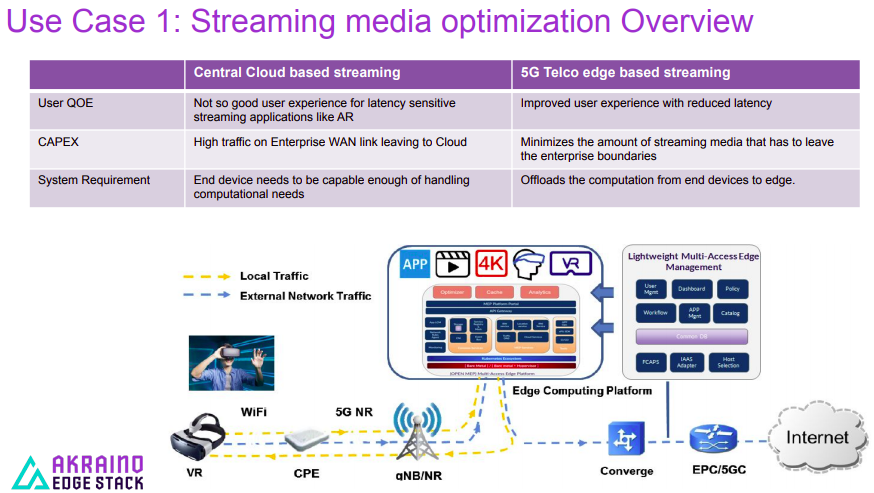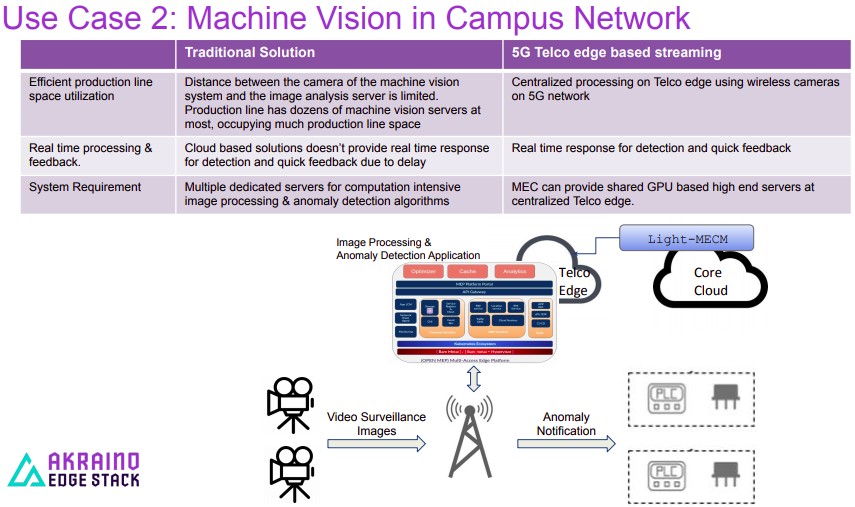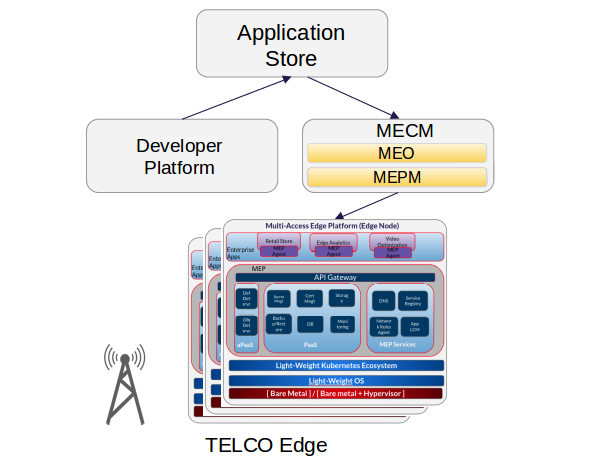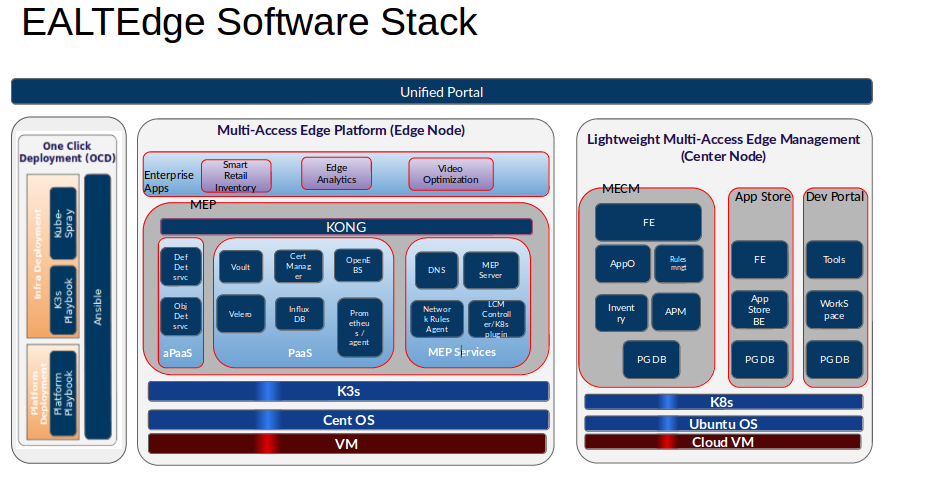Blueprint overview/Introduction
Enterprise Application on Lightweight 5G Telco Edge is an Akraino approved blueprint family, which intends to make a complete ecosystem for 5G Telco Edge Enterprise level platform. Platform which can be leveraged by various Telecom operators to give value added services to end users.
The edge layer which this blueprint targets is the Telco Edge.
Below are the high-level features which this blueprint will go on to implement in phase-wise.
- Lightweight MEP Solution
- Autonomous MEP Edge Sites.
- Unified Portal for platform management and for App developers.
- Sandbox with SDKs and tools chains for MEC app developers
- Heterogeneous deployment on Multi-Arch.
- ETSI MEC Compliant.
Use Case
Lightweight MEC platform, enable real-time enterprise applications on 5G telco edge.
Applications:
Diverse types of applications in various sectors, not limited to below:
● Gaming Applications, VR Live broadcasting
● The industrial park, Campus office etc.
● Video Orchestration and Optimization
● Latency Sensitive Application for Enterprise scenarios Etc
Use Case 1
Use Case 2
Use Case 3
Business Drivers
The EALTEdge Blueprint is for the Telco Edge, it targets the telecom operators to leverage this blueprint platform services and provide value added service, in return for better revenue generation. It also provide an Application Development Ecosystem by providing open SDK to developer community to develop application which can be tested and deployed easily on the MEP sites.
Overall Architecture
The Enterprise Applications on Lightweight 5G Telco Edge platform architecture consists of a MECM (Controller) Cluster (Cloud) and single to multiple MEC Host Sites .
The MECM Cluster is a Central Cloud Server which controls the deployment of applications on MEC Hosts. The MECM node can be a single node or a multiple node K8S Cluster.
Overall architecture diagram of the blueprint.
Figure 1 – EALTEdge R3 Architecture
CENTER
CENTER Node consists of 3 components. MECM , Applcm and Developer Platform. MEC Manager is the central entity in the MEC system responsible for application and service deployment in an highly distributed computing environment, it provides overall view of hosts and applications deployed in the hosts. MEC Manager is the central entity in the MEC system responsible for application and service deployment in an highly distributed computing
environment, it provides overall view of hosts and applications deployed in the hosts.
MECM comprises of MEP manager which performs the following tasks
➢ Application Package Management: On-boarding of application packages and if necessary adjusting them to comply with operator policies, keeping a record of on-boarded packages
➢ Applicatin LCM: Selecting appropriate MEC host(s) for application instantiation based on user inputs, keeping record of instantiated applications on specified hosts. Also carries out other LCM operations like query, deletion, termination etc.
EDGE Node
The EDGE are the components where the real action takes place. Edge Node components manages the execution of various Telco Edge Applications, it provides various services which can be leveraged by edge applications for smooth functioning and its planned to provide additional aPaas services like Machine Vision, Video Analytics , IoT Analytics etc in future releases. The MEP sites will be a single node or a multiple node K3S Cluster, on which applications will be deployed the MECM Application Management module. The MEC Host will be hosted on a light weight OS.
API: EALTEdge Blurprint provides ETSI compliance interfaces specified below for mentioned functionalities:
- MP1 : It is a interfaces between applications and MEP for Service Registry , Discovery and Service Availability Notification.
- MM3: It is a interface between Mobile Edge Orchestrator and the Mobile Edge Platform Manager is used for the management of the application lifecycle and keeping track of available mobile edge services.
Platform Architecture
The below diagram gives a overall architecture of the Enterprise Application on Lightweight 5G Telco Edge blueprint as given in Release 3.
Note: EALTEdge Blueprint Deployment has been tested on Cloud VM and is not tested on Bare-Metal Environment. Though, theoretically deployment should work in bare metal, provided hardware and software prerequisites are met. Kindly refer R4 - Test Documentation of Enterprise Applications on Lightweight 5G Telco Edge (EALTEdge) to get details on the tested deployment.
CENTER Components
- MECM: Regulates application and service deployment
- App Store:
- Developer Platform:
MECM Components:
- Dashboard
- Rules management
- Workflow / Policy
- Database
- IAAS Adapter
- Host Selection
- Catalog: Provides application package management
- Dashboard: Monitoring and Visualisation of platform and applications.
- Common DB: Persistent Database.
AppStore:
- Portal
- Appstore Services
- Repo
Developer Platform:
- Tools
- Workspace
- DB: Persistent Database
EDGE Node Components:
MEP:
MEP Provides API Gateway to achieve the below functionalities
- aPaaS:
- Defect Detection Service: This is a service to detect the defect when PCB images provided
- Object Detection Service: This service can be used by developer app for various Object detection for example Bottle detection and count for Retail store inventory.
- PaaS:
- Secret Management: Platform services and developer apps can use this service for sensitive info storing like password, cert etc.
- Cert Management: Platform services and developer apps can use this service for automate certifications management.
- Storage: Edge native storage for enterprise sites.
- Backup / Restore: scheduled backup, disaster recovery for remote sites
- DB: common DB for applications data
- Monitoring: system and apps health monitoring.
- MEP Services:
- DNS: DNS server and DNS record management service
- Service Registry: Service registry and discovery, availability notifications
- Network Rules management: service for handling data plane traffic rules.
- AppLCM: applications life cycle manage.ment
Software Platform Architecture
The below image shows the software platform distribution and architecture for Release 4.0.
EALTEdge Software Components
Unified CLI: Command Line Interface provides the user interface to install the EALTEdge environment.
CENTER Node -
MECM Services:
- Front End:
- AppO:
- Rules management
- Inventory
- APM
- Postgres DB
AppStore:
- Front End
- Appstore Backend
- Postgres DB
Developer Platform:
- Tools
- Workspace
- Postgres DB
EDGE Node Components:
MEP:
MEP Provides API Gateway to achieve the below functionalities
- aPaaS:
- Defect Detection Service: This is a service to detect the defect when PCB images provided
- Object Detection Service: This service can be used by developer app for various Object detection for example Bottle detection and count for Retail store inventory.
- PaaS:
- Vault: Vault is a tool for securely accessing secrets. A secret is anything that you want to tightly control access to, such as API keys, passwords, certificates, and more. Vault provides a unified interface to any secret while providing tight access control and recording a detailed audit log.
- Cert Management: cert-manager is a native Kubernetes certificate management controller. It can help with issuing certificates from a variety of sources, such as Let’s Encrypt, HashiCorp Vault, Venafi, a simple signing key pair, or self signed. It will ensure certificates are valid and up to date, and attempt to renew certificates at a configured time before expiry.
- OpenEBS: OpenEBS is a Kubernetes native hyperconverged storage solution. OpenEBS consumes the storage (disks, SSDs, cloud volumes, etc) available on the Kubernetes worker nodes to dynamically provision Kubernetes Persistent Volumes.
OpenEBS can provision different type of Local PV for Stateful Workloads like Cassandra, MongoDB, Elastic, etc that are distributed in nature and have high availiability built into them. Depending on the type of storage attached to your Kubernetes worker nodes, you can select from Dynamic Local PV - Hostpath, Device, ZFS or Rawfile.
- Velero: Velero is an open source tool to safely backup and restore, perform disaster recovery, and migrate Kubernetes cluster resources and persistent volumes.
- Influx DB: Time series data base for user applications data.
- Prometheus Agent: cAdvisor, NodeExporter
- MEP Services:
- DNS
- Service Registry : The service registry provides visibility of the services available on the MEC server. It uses the concept of loose coupling of services, providing flexibility in application deployment. In addition, the service registry presents service availability (status of the service) together with the related interfaces and versions. It is used by applications to discover and locate the end-points for the services they require, and to publish their own service end-point for other applications to use. The access to the service registry is controlled (authenticated and authorised).
- MEP server: MEP platform services like service registry, discovery, DNS, traffic rules etc.
- Network and Rules management
- AppLCM: LCM controller and K8s plugin
Below are details of Upstream and Opensource software's used in various nodes of EALTEdge Environment.
OCD Node
S. No. | Software Name | Category | Version Number | Remarks |
|---|---|---|---|---|
| 1. | Ubuntu | OS | 18.04 | Supports both 16.04 and 18.04 |
| 2. | GIT | Version Control | 2.17.1 | |
| 3. | Ansible | Scripting Tool | > 2.5 | |
| 4. | GoLang | Language | 1.14+ | |
| 5. | KubeSpray | Tool | 2.13 |
CENTER Node
S. No. | Software Name | Category | Version Number | Remarks |
|---|---|---|---|---|
| 1. | Ubuntu | OS | 18.04 | Supports both 16.04 and 18.04 |
| 2. | Kubernetes | Orchestration | 1.19.3 | |
| 3. | Docker | CRI | 19.03+ | |
| 4. | Helm | Application Package Manager | 3.0.2 | Running as Bin in MECM For ARM - 64 and X86 |
| 5. | Grafana | Analytics Dashboard | 8.7 | Running as POD in K8S Cluster |
| 6. | Postgres SQL | Database | 9.6 | |
| 7. | Edge Gallery | MultiAccess Edge Computing Platform | 0.9 | Opensource MEC Platform |
EDGE Node
S. No. | Software Name | Category | Version Number | Remarks |
|---|---|---|---|---|
| 1. | Ubuntu | OS | 18.04 | Supports both 16.04 and 18.04 |
| 2. | Docker | CRI | 19.03 | |
| 3. | K3S | Orchestration | 1.18.2 | |
| 4. | Helm | Application Package Manager | 3.0.2 | |
| 5. | Prometheus | Monitoring | 2.18 | |
| 6. | CAdvisor | Container Metrics | 0.36 | |
| 7. | RabbitMQ | Message Queue | 3.7 | |
| 8. | Cert-Manager | Certification Management | 0.15.0 | |
| 9. | Kong | API Gateway | 1.5.1 | |
| 10. | Vault | Secret Management | 0.5.0 | |
| 11 | Postgres SQL | Database | 9.6 | |
| 12 | Edge Gallery | MultiAccess Edge Computing Platform | 0.9 | Opensource MEC platform |
APIs
Please refer the API Documentation link : R4 - API Documentation Enterprise Application on Lightweight 5G Telco Edge (EALTEdge)
Hardware and Software Management
Hardware Management
Currently for this blueprint Huawei Cloud Virtual Machines are being used for development , testing and CD hence there is no specific hardware management to be done.
Software Management
Gerrit Repo : EALT Gerrit Repo
Licensing
GNU/common license






